Popcorn is a beloved snack that has been enjoyed for centuries. But have you ever wondered what exactly a popcorn kernel is? A popcorn kernel is the seed of corn, scientifically known as Zea mays everta. It is a hard, dry, and yellow, red, white, or blue kernel that contains a plant embryo, a starchy endosperm, and a tough exterior husk. These three main components combine to create the magical process of popping corn, resulting in the fluffy, crunchy popcorn we all love.
Key Takeaways:
- A popcorn kernel is the seed of corn, consisting of a plant embryo, starchy endosperm, and a tough husk.
- Popcorn kernels undergo a transformation when heated, resulting in the fluffy, crunchy popcorn we enjoy.
- Popcorn kernels come in different colors such as yellow, red, white, and blue.
- Understanding the composition of popcorn kernels adds to the enjoyment of this popular snack.
- Popcorn has been enjoyed for centuries and holds cultural significance.
Popcorn Varieties: Exploring the Different Types of Popcorn
When it comes to popcorn, there’s more than meets the eye. It’s not just a one-size-fits-all snack. In fact, there are numerous varieties of popcorn, each with its own distinctive characteristics and flavors. Let’s take a closer look at some of the gourmet specialty popcorn varieties that are sure to tantalize your taste buds.
1. Rice Popcorn
This type of popcorn has smaller, delicate kernels that are reminiscent of grains of rice. It pops into tiny, tender morsels that are perfect for snacking or adding to recipes like popcorn balls or trail mix.
2. Pearl Popcorn
Pearl popcorn is known for its spherical shape and pearly appearance. It has a satisfying crunch and is often used in gourmet popcorn mixes due to its unique texture and ability to hold up well to seasonings and coatings.
3. Multi-Colored Popcorn
If you’re looking for a visually stunning popcorn experience, try a variety of multi-colored popcorn. You’ll find kernels in vibrant hues of red, black, rainbow, yellow, white, and blue. This popcorn not only looks beautiful but also provides a diverse range of flavors.
4. Mushroom Popcorn
Mushroom popcorn gets its name from its unique shape, resembling a mushroom cap. It has a larger, rounder kernel that pops into a ball-like shape with a sturdy texture. This variety is often used for caramel or chocolate-coated popcorn due to its ability to hold up well to heavy coatings.
These are just a few examples of the many popcorn varieties available today. Popcorn companies are continually developing new hybrids and experimenting with flavors to expand the popcorn universe. So, the next time you’re craving a bowl of popcorn, consider exploring these gourmet specialty popcorn varieties for a truly exceptional snacking experience.
The Science Behind Popcorn: How Does Popcorn Pop?
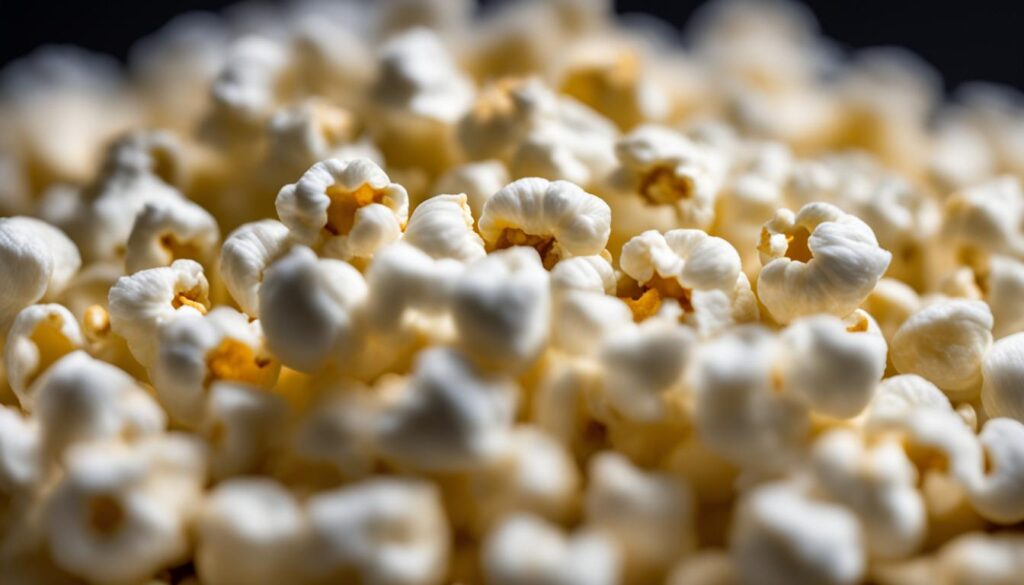
Popcorn is a fascinating snack that undergoes a magical transformation when heated. But have you ever wondered how exactly popcorn pops? Let’s dive into the science behind this delightful treat.
Inside each popcorn kernel, there are three key components: a plant embryo, a starchy endosperm, and a hard exterior called the bran or hull. When heat is applied to the dried kernels, a small droplet of water within the kernel turns into steam. As the steam builds up pressure, the hull can no longer contain it, causing the kernel to explode.
The explosion unleashes the starchy endosperm, which rapidly expands and turns into the fluffy popcorn we know and love. The cooking method also plays a role in the popping process. Dry heat, such as in an air popper, relies solely on the moisture within the kernel. On the other hand, when popcorn is cooked in oil, the oil helps distribute heat evenly and provides additional flavor.
Popcorn Ingredients:
- Popcorn kernels
- Heat source (e.g., stovetop, microwave, air popper)
- Optional: oil, butter, salt, seasonings
So, the next time you’re enjoying a bowl of popcorn, take a moment to appreciate the science behind its popping. It’s truly a remarkable process that turns a simple kernel into a fluffy and irresistible treat.
Cooking Popcorn Tips:
- Choose the right container: When using a stovetop or microwave, opt for a heat-safe vessel with a lid to contain the popping kernels.
- Listen for the pops: Pay attention to the popping sound. Once the pops slow down to around two seconds between each pop, it’s time to remove the popcorn from the heat source.
- Season to taste: After cooking, feel free to add your favorite toppings or seasonings to enhance the flavor of your popcorn.
Farming Popping Corn: Cultivating and Harvesting Popcorn
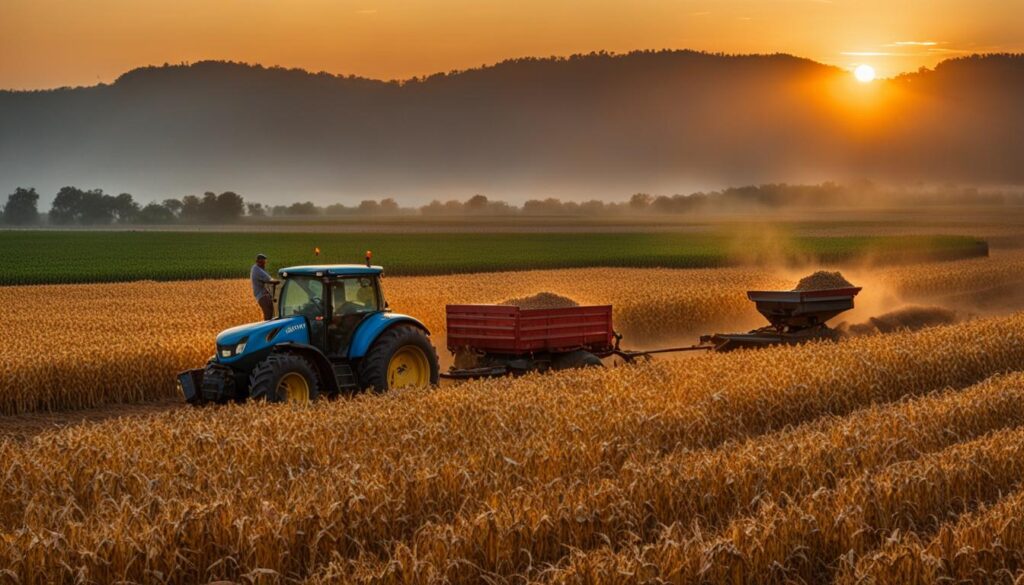
Popcorn hybrids are carefully cultivated and harvested to ensure the best quality popping corn. The process begins with the selection and breeding of specific hybrids that possess desirable traits such as disease resistance, ease of growth, and sturdy stalks. These hybrids are specifically developed for different purposes, such as microwave popcorn or movie theater popcorn, to cater to different consumer preferences.
To cultivate popping corn, farmers plant the kernels in rows that intersect at 90-degree angles, allowing for efficient spacing and maximum yield. The soil needs to be nutrient-rich to provide the necessary nourishment for the corn plants to grow. Throughout the growing season, farmers closely monitor the crop, ensuring that it receives adequate water and nutrients to thrive.
When the popping corn is ready for harvest, farmers carefully collect the ears of corn from the stalks. The corn is then dried for several months to reduce moisture content and optimize its popping potential. After the drying process, the popping corn is taken to the factory for further processing, where it undergoes cleaning, sorting, and packaging to ensure its quality and freshness.
Popping Corn Cultivation Process:
- Selecting and breeding specific hybrids with desirable traits
- Planting the kernels in rows with 90-degree angles
- Monitoring the crop throughout the growing season
- Harvesting the ears of corn and drying them for several months
- Processing the popping corn in the factory for cleaning, sorting, and packaging
By following these careful cultivation and harvesting processes, farmers ensure that the popping corn you enjoy is of the highest quality, delivering the perfect pop and taste.
The Origins of Popcorn: A Brief History
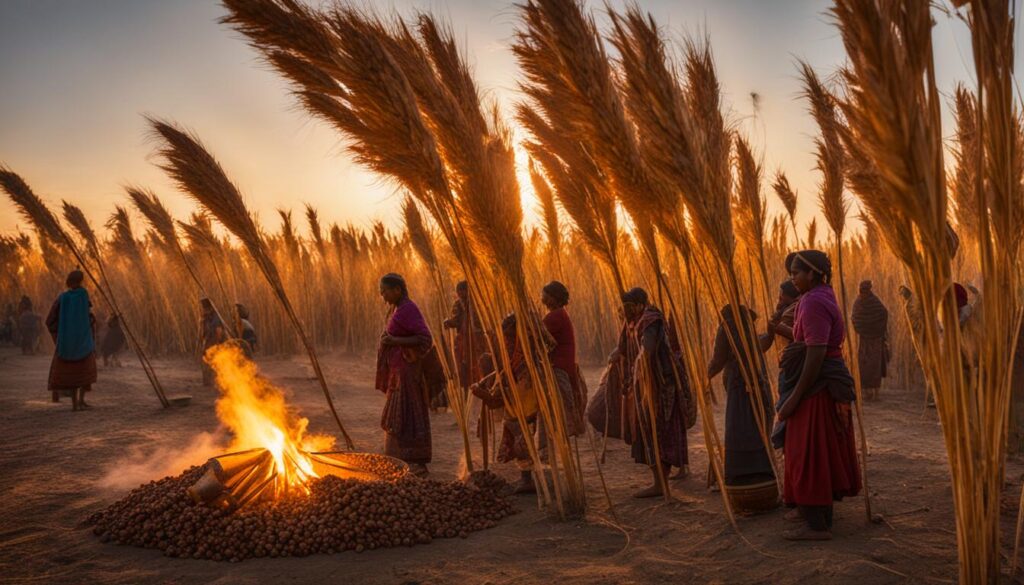
Popcorn, the beloved snack enjoyed by millions, has a fascinating history that stretches back thousands of years. Its origins can be traced to the Aztecs in the Valley of Mexico, where they cultivated a special type of maize called teosinte. This ancient popcorn was unlike the fluffy kernels we know today; instead, it produced small, hard kernels that were often used for decorative purposes.
The Aztecs held popcorn in high regard and used it in religious ceremonies and celebrations. They believed that the popping sound represented the spirits’ voices, making popcorn a significant part of their cultural and spiritual traditions. Popcorn kernels have even been found in ancient burial sites, reinforcing its importance in Aztec society.
Popcorn’s Journey to the United States
Popcorn made its way to the United States in the early 1800s, and its popularity quickly spread. By the mid-19th century, popcorn had become a common snack at fairs, carnivals, and circuses, where it was often popped and sold on the spot. It became a symbol of entertainment and leisure, enjoyed by people of all ages.
Over time, popcorn became a staple in American households, thanks to the invention of the popcorn machine in the late 19th century. This invention made it easier and more convenient to pop corn at home, solidifying popcorn’s place as a beloved snack for movie nights, parties, and cozy evenings.
Popcorn Folklore and Cultural Significance
Throughout its history, popcorn has been surrounded by folklore and cultural significance. Native American tribes, such as the Iroquois and the Cherokee, have their own stories and legends about popcorn, passing down traditions from generation to generation. In some Native American cultures, popcorn symbolizes prosperity, fertility, and good fortune.
Today, popcorn continues to be a cherished snack that brings people together. Whether enjoyed at the movies, during game nights, or while cozying up on the couch, popcorn is a timeless treat that carries with it the rich history and cultural significance of its origins.
Popcorn vs Corn: What Sets Popcorn Kernels Apart?
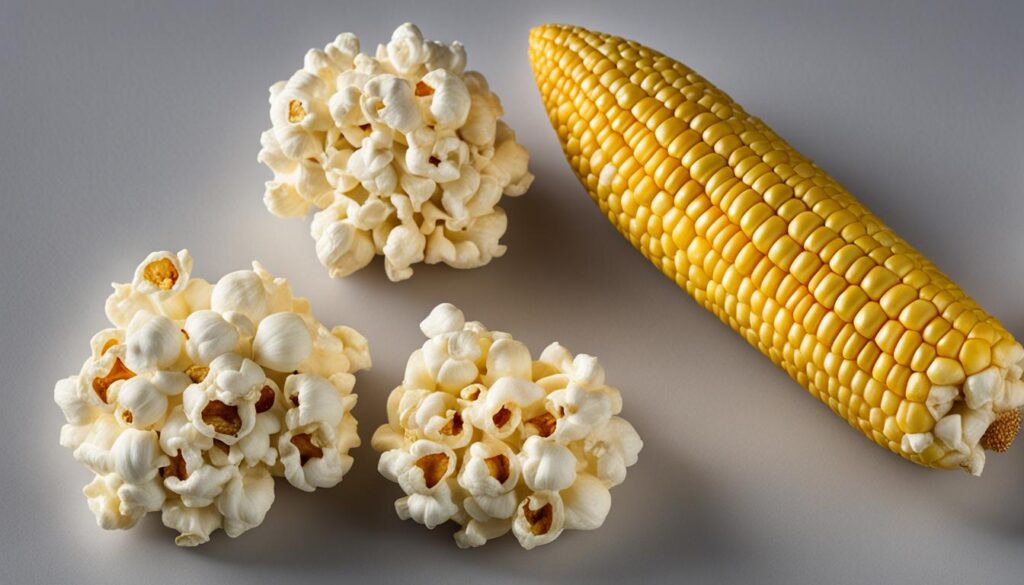
Popcorn and corn may come from the same family, but they have distinct differences that set them apart. Let’s explore the unique characteristics of popcorn kernels and how they differ from regular corn.
Differences between Popcorn and Corn:
- Outer Shell: Popcorn kernels have a tough, nonporous outer shell or husk. This characteristic allows the kernel to trap steam and build pressure during the popping process. In contrast, corn varieties like sweet corn have softer husks that do not create the same popping action.
- Moisture Content: Popcorn kernels contain the perfect balance of moisture to create the popping effect. Other types of corn, such as sweet corn, have higher water content, which prevents them from properly popping.
Sweet Corn vs Popcorn:
One common misconception is that sweet corn can be popped like popcorn. However, the differences in husk thickness and moisture content make sweet corn unsuitable for popping. Sweet corn is typically enjoyed in its fresh or canned form, while popcorn is specifically bred and processed for its popping capabilities.
Popcorn Kernel Composition:
The composition of popcorn kernels contributes to their popping ability. Each kernel contains a hard outer shell that traps moisture and steam, a starchy endosperm that transforms into the fluffy popcorn, and a plant embryo. This unique combination results in the explosive and delicious transformation we know and love.
Now that you understand the differences between popcorn and corn, you can appreciate the science behind this beloved snack. Popcorn kernels possess special qualities that make them ideal for popping, giving us the joy of enjoying fluffy, crunchy popcorn whenever we want. So next time you reach for a bowl of popcorn, remember the unique characteristics that make it a distinct member of the corn family.
Conclusion: Enjoy the Fascinating Science of Popcorn
After exploring the world of popcorn, we can’t help but be amazed by the fascinating science behind this beloved snack. From understanding what a popcorn kernel is to learning about the different varieties and the process of popping, there’s so much more to popcorn than meets the eye.
Popcorn is made possible by its unique genetic composition. The combination of a plant embryo, starchy endosperm, and a tough exterior creates the perfect conditions for the magical popping phenomenon. When heat is applied, the steam builds up inside the kernel until it explodes, revealing the delicious fluffy popcorn within.
Whether you prefer the classic movie theater popcorn or enjoy experimenting with gourmet specialty varieties, there’s no denying that popcorn is a delightful treat. Its rich history, dating back thousands of years, adds to its cultural significance and makes every bite even more special.
So the next time you sit down with a bowl of popcorn, take a moment to appreciate the science and craftsmanship that goes into this simple yet extraordinary snack. Let’s savor the crunchy, fluffy goodness and celebrate the wonder of popcorn. Enjoy!
FAQ
What is a popcorn kernel?
A popcorn kernel is the seed of corn, scientifically known as Zea mays everta. It is a hard, dry, and yellow, red, white, or blue kernel that contains a plant embryo, a starchy endosperm, and a tough exterior husk.
What are some popular types of popcorn?
Some popular types of popcorn include rice popcorn, pearl popcorn, red, black, rainbow, yellow, white, and blue popcorn. These gourmet specialty popcorn varieties are continually being developed by popcorn companies’ scientists to improve the “pop” and taste.
How does popcorn pop?
The secret to popcorn’s popping lies in the kernel’s composition. Inside each kernel is a plant embryo, a starchy endosperm, and a hard exterior called the bran or hull. When heat is applied to the dried kernels, the small droplet of water within the kernel turns into steam, creating pressure. Once the hull can no longer contain the pressure, the kernel explodes, and the starch inside turns into the fluffy popcorn we know. Different cooking methods, such as dry heat or using oil, affect the popping process and result in different textures and flavors.
How is popping corn cultivated and harvested?
Popping corn is cultivated through careful selection and breeding of specific hybrids with desired traits like disease resistance, ease of growth, and sturdy stalks. These hybrids are used for different purposes, such as microwave popcorn or movie theater popcorn. Popping corn is planted in rows intersecting at 90-degree angles in nutrient-rich soil. After the corn is harvested, it is dried for several months before being taken to the factory for further processing. This process ensures the best quality popping corn.
What is the history of popcorn?
Popcorn has a rich history that dates back thousands of years. It originated with the Aztecs in the Valley of Mexico, where they grew a special maize known as teosinte. Archaeological discoveries have unearthed 6,700-year-old popcorn kernels in Peru, proving its longstanding existence. Popcorn was enjoyed by the Aztecs before it gained popularity in the United States in the early 1800s. The folklore surrounding popcorn has been passed down through Native American cultures, adding to its cultural significance.
What sets popcorn kernels apart from other types of corn?
While popcorn is a type of corn, not all corn can be popped. The physical and chemical composition of popcorn kernels sets them apart from other types of corn. Popcorn kernels have a tough, nonporous outer shell and contain the right amount of moisture. These characteristics allow the kernel to trap steam and build pressure, leading to the explosive popping action. In contrast, other varieties of corn, such as sweet corn, have softer husks and different starch and water levels that prevent them from popping.
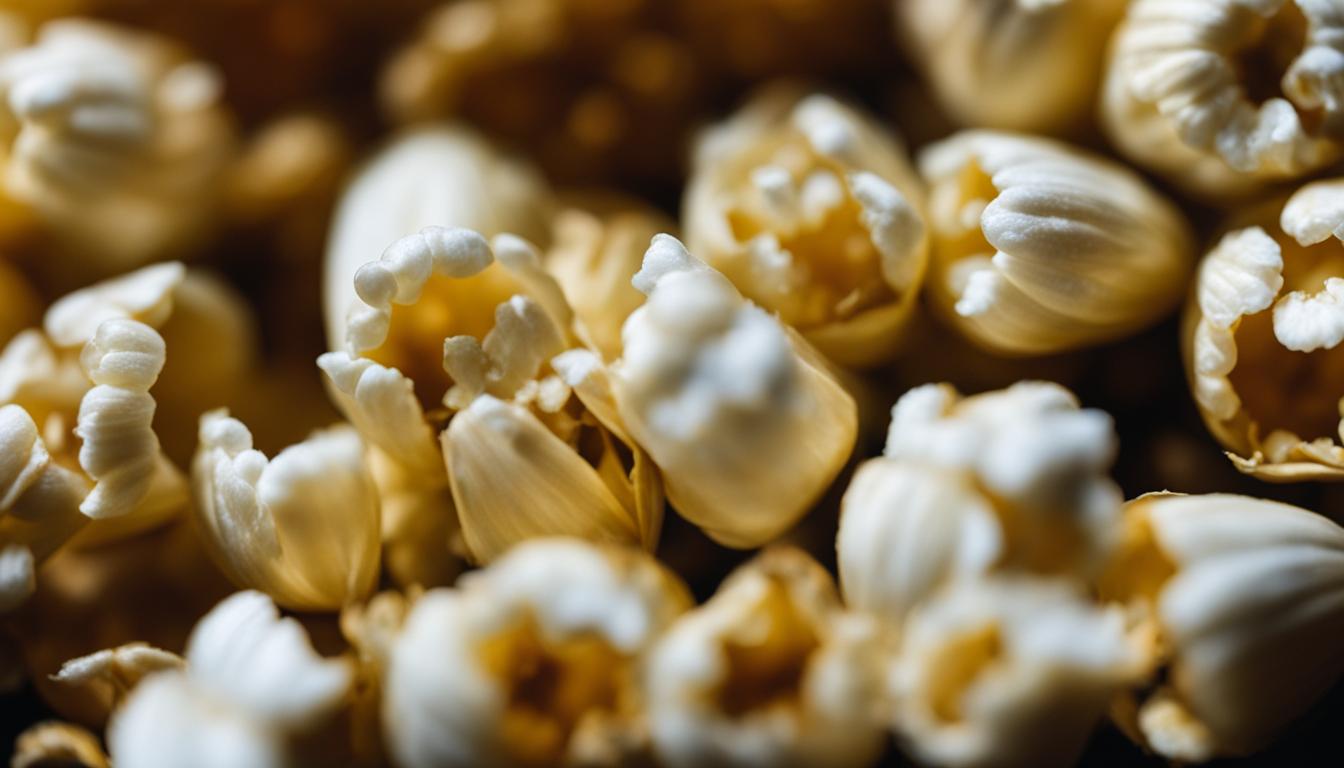
Leave a Reply